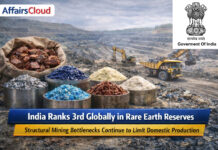 The 2020 Human Capital Index (HCI) is a collaboration between the Human Development Practice Group and the Development Economics Group of the World Bank.World Bank released the report titled “The Human Capital Index 2020 Update: Human Capital in the Time of COVID-19”on September 16, 2020. India has been placed at the 116th position among 174 countries in the Human Capital Index 2020 with score increase to 0.49 from 0.44 in 2018 in comparison to 115 out of 157 countries.
The 2020 Human Capital Index (HCI) is a collaboration between the Human Development Practice Group and the Development Economics Group of the World Bank.World Bank released the report titled “The Human Capital Index 2020 Update: Human Capital in the Time of COVID-19”on September 16, 2020. India has been placed at the 116th position among 174 countries in the Human Capital Index 2020 with score increase to 0.49 from 0.44 in 2018 in comparison to 115 out of 157 countries.
- The country of Singapore topped the score with 0.88 followed by Hong Kong at 0.81 and Japan at 0.80.
- Human capital is the stock of habits, knowledge, social and personality attributes embodied in the ability to perform labour so as to produce economic value.
- The report based on recent cross-section of 174 economies for the five HCI components (child survival, expected years of school, harmonized test scores, fraction of children under 5 not stunted, and adult survival), as used to calculate the 2020 HCI.
Top 3 Countries in HCI
| Rank | Country | Score |
| 116 | India | 0.49 |
| 1 | Singapore | 0.88 |
| 2 | Hongkong and China | 0.81 |
| 3 | Japan | 0.80 |
About 2020 Human Capital Index (HCI):
The 2020 Human Capital Index update includes health and education data for 174 countries covering 98% of the world’s population up to March 2020. It provided a pre-pandemic baseline on the health and education of children.
- Measuring the human capital that a child born today can expect to attain by her 18th birthday, the HCI highlights how current health and education outcomes shape the productivity of the next generation of workers.
Key Points:
–Globally, the HCI 2020 shows that, before the pandemic struck, a child could expect to attain an average of 56% of her potential productivity as a future worker.
–As per the index pre-pandemic, most countries had made steady progress in building human capital for children specially low-income countries.
–80 million children are missing out on essential vaccinations and more than a billion children have been out of school due to COVID. This could lose USD 10 trillion in lifetime earnings because of the reduced learning.
–There are disruptions to essential health services for women and children.
–There is a major decline in remittances and total income is going down by 11 or 12%.
–Human capital is slightly higher among girls than boys in most countries. Girls are not only catching up to but outperforming boys in expected years of schooling and learning outcomes in some regions.
–In survival and health outcomes, girls are generally better off than boys except India and Tonga.
Recent Related News:
i.India’s ranking rose to 27th position in the World Bank Doing Business Report (DBR) 2020, in the Ease of Doing Business in Construction Permits, moving up from 181 rank in DBR 2018, showing remarkable improvement since the implementation of the reforms.
ii.According to the New World Bank country classifications by income level 2020-2021, India remains in the classification, Lower-Middle-Income Economy. In total, 218 countries have been included in this classification. The World Bank classifies countries into four income groups namely: low income, lower-middle income, upper-middle income, and high-income economies.
About World Bank:
President– David Robert Malpass
Headquarters– Washington, D.C., United States




